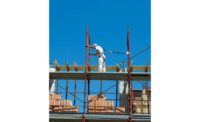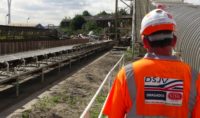With so much safety training, hazard abatement and personal protective equipment, why do construction injuries persist?
The answer may be that workers tend to take more risks when they feel protected by strict safety measures such as perimeter barriers and tie-offs on roofs, but these may not provide as much protection as they think, suggests a research study using virtual reality that is gaining attention. The innovative research method is being expanded from roofers and fall protection to other trades.
Engineers had suspected that a phenomenon observed in motorists, that they "compensated" for safer automobiles by driving faster, could have an analog in construction work and safety.
Researchers, who work for top university engineering programs, devised a system in which subjects trained in a roofing task were asked to work in a mixed-reality environment, on a real sloped roof assembly, which created the sensation of a 20-foot height.
A team of civil engineering scholars, whose work was originally published online a year ago in the ASCE Journal of Construction Engineering and Management, sought to find out if the suspicion was true. Their journal article has been downloaded over 400 times.
The researchers, who work for top university engineering programs, devised a system in which subjects were trained in a residential roofing task and asked to work in a mixed-reality environment—known by the recursive acronym CAVE, for automatic virtual environment. It is a room-sized immersive environment that, for the initial study, created the sensation of height as the subjects worked on a real sloped-roof assembly. As suspected, the tighter the safety measures, the closer to the edge of the roof the workers allowed themselves to go.
The research opens several new avenues for exploration about how other craft workers may add to their own peril in safety compliant workplaces, and what to do about it.
Sogand Hasanzadeh, lead author and a PhD candidate at Virginia Tech when the initial study was carried out, says the initial research project was the first of a series of studies that will expand to include line work by electrical workers and other craft tasks. Those forthcoming studies, being conducted now at Purdue University, will include the impact of productivity demand and time pressure on worker risk compensatory behavior, she says.
Hasanzadeh, now on the Purdue faculty, says she and her team were investigating how "workers may fall prey to cognitive bias as shortcuts that will ultimately lead to risky decisions." If that happens, "no matter how many safety prevention measures are in place, they will not be enough."
"Workers need to be aware that having protection doesn’t mean they are fully protected," she says.
Jesus M. de la Garza, professor and civil engineering department chair at Clemson University, says human beings are regularly resetting their own internal risk thermostat.
"Every risk tolerance is different," says de la Garza, who along with E. Scott Geller, a Virginia Tech psychology professor, were co-authors of the study. "When we make people safer, they feel safer, so the natural tendency is for people to go back to the target level of risk that makes them comfortable and risk-taking behavior restores risk to the level that’s comfortable."
That theory, risk compensation, was developed by safety engineers in the 1980s and partly explains continuing injuries in the construction industry.
Why has the return on the safety investment, in various training techniques and in equipment, not been greater? And why can't construction get to zero injuries on more projects, and zero fatalities? Those were some issues the researchers probed.
A rising total number of fatal falls in construction from 2011 to 2015 drew researchers' attention to roofing.
After recruiting 33 students with at least a year of construction work experience, researchers trained them on how to install roofing shingles, and then divided them into groups. The subjects were equipped with virtual reality 3-D glasses with embedded location sensors, wearable physiological technology.
The subjects also were fitted with additional ankle sensors to track their locations. After directing students to a CAVE virtual environment room with a 27-degree sloped residential roof assembly on the floor, researchers asked groups with different levels of protection to complete the designated roofing activity, Some members wore only personal protective equipment (hard-hat, gloves and knee-pads) but no fall protection; some wore PPE and a fall-arrest system; and a third group had PPE, a fall-arrest system and a perimeter guardrail.
The mixed-reality environment and simulated wind and sound were programmed to model a typical suburban street with two-story homes—creating the sensation of being on a two-story high roof, when they were really standing on a sloped roof assembly on a flat surface.
More Risk-Taking and Possible Solutions
Everything was videotaped and changes in movements, perceived risks and decision dynamics were subject to extensive statistical analysis.
The study found that the more protections in place, the closer the subjects moved themselves to the roof edge and the more they allowed themselves to lean out over the edge, demonstrating excessive risk-taking behavior.
The subjects believed the fall protection measures would fully protect them or guarantee less-serious injury, the authors wrote, and were "interpreted as an increased sense of invulnerability."
According to the researchers, "such results may explain why injury rates have remained at worrisome levels despite advances and additions of protective measures within the construction industry."
The results could point to several possible needed changes in construction safety practices, says Hasanzadeh, including raising worker awareness of risk-compensation and new safety equipment that provides real-time warnings to workers through sensors that track locations and watches that vibrate.






Post a comment to this article
Report Abusive Comment